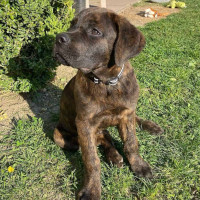Appearance of the Rotticorso
|
| The Rotticorso has a solid body shape, slightly longer than it is tall. Their attractive coat of short straight hair fits firmly to the body and compliments the dog's appearance of power and strength. Their legs are strong yet elegant, and their paws are rounded and well padded, enabling fast action from running to chasing. Their chest is deep and supports a muscular neck. Rotticorso have a blocky head, with a strong narrow muzzle and teeth that meet in a scissor bite. Their eyes are a deep amber or brown, and often edged in black, giving them a very expressive face. The nose is black with large nostrils. The ears can vary according to the genetic influence of the parent dogs, but generally they are held back from the face and are triangular in shape, which are floppy at the top. The Rotticorso has the appearance of a dog that is comfortable in its own skin, and is intelligent and affectionate as a companion and worker in times of need. |
Temperament of the Rotticorso
|
| Although a big dog, the Rotticorso doesn't like to be left alone for long, they get bored easily and want to be with their owners and family, the “pack”, if you like. They are devoted and loyal dogs, and are very active dogs, coming from a working dog background. These dogs are best in a home with a secure yard to explore and do their own thing. They'll follow you around the property and into the house just to see what you're up to. The Rotticorso dog is intelligent, a little stubborn and will try to be the boss. They need a strong owner who can put them in their place, someone they can respect. The savvy owner can bend the Rotticorso dog to do his bidding by praising them when he does well, and rewarding good behavior and obedience with tasty treats. Your dog will soon be too willing to adopt training only if it's fun and gets your individual attention. These dogs are good family dogs, often forming strong bonds within the family group, but can remain reserved and politely aloof with family friends or distant members. Socializing your Rotticorso dog while it's a young puppy will help them become a well-rounded dog in the wild. Be sure to meet a variety of people and other dogs so they get used to the noise and activity of a group of people and pets. Rotticorso dogs have strong hunting instincts, so they'll go after neighbors' cats and other small animals. Keep them behind a strong, contained fence to avoid problems, and keep them on a leash when walking. While your Rotticorso dog looks impressive, acts impressive and is undoubtedly impressive in personality, he can also be a mellow weakling when it comes to affection and cuddles. |
Needs and activities of the Rotticorso
|
| The Rotticorso dog comes from a back yard and, as such, they're not the kind of dog who wants to sit idle all day. These dogs need a daily walk, or two if possible, to get rid of some of their energy. They make ideal jogging or cycling companions, and will happily accompany you into your training zone. Keep them on a leash, as they have strong hunting instincts and may take off after a small, fast-moving animal they consider prey. Having to chase your dog to regain control is not much fun. They'll enjoy playing at home in a well-fenced yard - these dogs need that fence to hold them back, and will even love a few toys to play with. Rotticorso can be reserved for strangers, including children, as well as other dogs, so make sure you're there to handle any play. They're a big dog and can be unintentionally rough with small children, so supervise their playtime in case little ones get knocked over and hurt. Rotticorso dogs will also enjoy water play and love to cool off in the summer in a river or the sea. Keep these dogs well exercised and working and you'll have a fluffy, affectionate dog. |
Maintenance of the Rotticorso
|
| Rotticorso are relatively easy to maintain and groom, they have a season shedding which will mean instead of weekly brushing, they will require daily brushing, but apart from that, they are minimal care. While brushing, this is the ideal time to check your dog to make sure they don't have any cuts or abrasions that need attention. Their ears need constant checking in case infection sets in, and check that their eyes are clear and tear-free. Using a mild dog shampoo will keep their skin healthy and preserve natural oils. Oral hygiene requires that your dogs' teeth be brushed at least twice a week to keep their teeth healthy and their breath sweet. Finally, a light nail trim will finish off your Rotticorso's grooming and reward your dog with a healthy treat for being such a good dog. |









 English (United Kingdom)
English (United Kingdom)